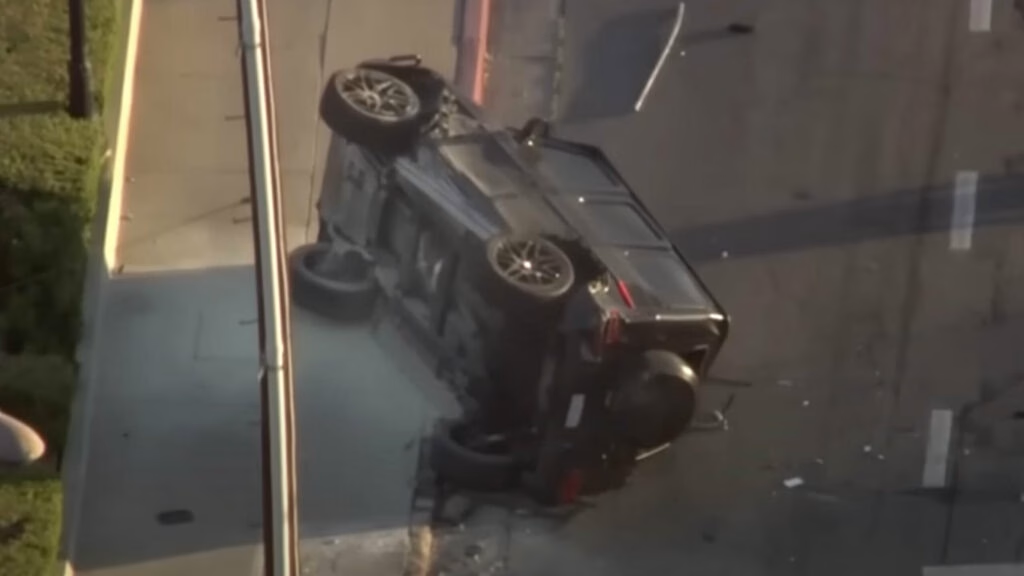What Really Happened When a Stolen Mercedes G-Class Was Flipped by a Prius in Los Angeles?
If you saw a Mercedes-Benz G-Class barreling down a city street, you’d probably assume it could plow through just about anything. After all, the G-Wagen is famous for its tank-like build and luxury status. But in a wild Los Angeles police chase that ended in Pasadena, one stolen G-Class met its match in the most unexpected way: a collision with a humble Toyota Prius. The result? Pure chaos—and a few lessons about physics, car chases, and why size isn’t always everything.
How Did a High-Speed Chase Lead to Such a Dramatic Crash?
It all started on a Wednesday evening near Century Boulevard and Figueroa Streets. Police were tipped off about a stolen G-Class SUV and quickly gave chase when the driver refused to pull over. The pursuit snaked through the northbound lanes of the 110 Freeway before spilling into the quieter streets of Pasadena.
Here’s where things got dicey. As the Mercedes sped through the intersection at Foothill and Sierra Madre boulevards—ignoring a red light—a Toyota Prius entered from the side. The two vehicles collided in a classic T-bone crash. The force was so intense that the Prius spun 180 degrees, while the G-Class was sent airborne, flipping over and rolling several times before coming to a battered stop.
Why Did the G-Class Flip So Easily Despite Its Size?
You’d think a burly SUV like the G-Class would shrug off a hit from a Prius. But physics doesn’t care about price tags or prestige. The G-Class, while heavy, has a high center of gravity—great for off-roading, not so great for sudden sideways impacts. When the Prius struck, it acted like a lever, lifting the Mercedes and tipping it over. The G-Class’s weight actually worked against it, making it harder to regain balance once it started to roll.
This isn’t just a fluke, either. According to the National Highway Traffic Safety Administration (NHTSA), vehicles with higher centers of gravity are up to three times more likely to roll over in side-impact crashes compared to sedans. It’s a sobering reminder that even the most robust vehicles have their vulnerabilities.
What Happened to the People Involved?
Miraculously, no fatalities were reported. Police quickly took the driver of the stolen G-Class into custody at the scene. The Prius, though badly damaged at the front, came to a stop almost immediately after the crash. The G-Class, on the other hand, looked like it had been through a demolition derby—its roof crumpled, windows shattered, and body panels twisted.
But the chaos didn’t end there. During the pursuit, a Ford Explorer police cruiser also crashed into a building along Walnut Street. Details are still murky about how that happened, but it highlights how unpredictable and dangerous high-speed chases can be—not just for suspects, but for officers and bystanders alike.
Are High-Speed Police Chases Worth the Risk?
This incident reignites a long-running debate in law enforcement circles: when is it worth it to pursue a fleeing suspect at high speeds? According to a 2022 study from the International Association of Chiefs of Police, nearly 40% of police pursuits end in a crash, and about 20% result in injuries to either suspects, officers, or civilians. Departments across the country have been re-evaluating their pursuit policies, with some opting for stricter guidelines or even banning high-speed chases for non-violent offenses.
In Los Angeles, police chases are a regular feature on local news, but each one carries significant risk. The G-Class incident is a perfect example—what started as a property crime ended with multiple wrecked vehicles and a city block turned into a crash scene.
What Can We Learn About Vehicle Safety from This Crash?
If there’s a silver lining, it’s that modern vehicles—even the Prius—are built to absorb and dissipate crash energy, protecting occupants as much as possible. The fact that both drivers survived such a violent impact speaks volumes about advances in automotive safety engineering. Crumple zones, reinforced cabins, and airbags all played a role in preventing a tragedy.
But no amount of engineering can fully compensate for reckless driving or the unpredictable nature of a police chase. The best safety feature? Avoiding the situation altogether.
The Big Takeaway
Size and status don’t guarantee invincibility on the road—physics always wins. Whether you’re driving a luxury SUV or a basic hybrid, smart choices and respect for the rules of the road are what keep you safe. The big takeaway? Staying out of trouble isn’t about perfection—it’s about smarter adjustments. Start with one change this week—maybe slowing down at that yellow light or double-checking intersections—and you’ll likely spot the difference by month’s end.

